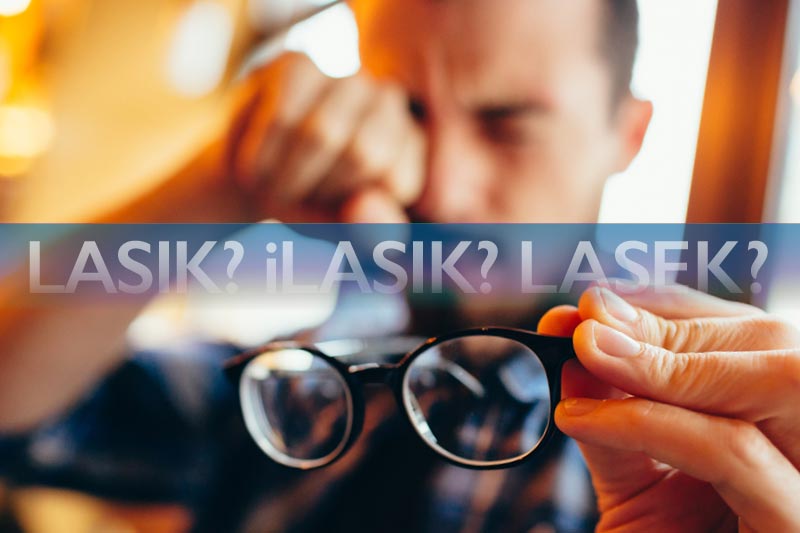If you’ve worn glasses or contact lenses your whole life, you’ll know how important it is to find an Optometrist you are comfortable expressing your vision concerns with. When it comes to laser eye surgery, we all want to make sure our doctor is providing us with the most advanced and trusted technology. And even though doctors are trusted professionals, it’s just as important to educate yourself on the various treatments available for our eyes.
With a variety of clinics, it can sometimes be hard to sift through all the medical noise and jargon and decipher which treatment is really best to treat nearsightedness, farsightedness and astigmatism. We’ve all heard the names LASIK, iLASIK™ and LASEK before, but what is really the difference between all of them? Well, we’ve talked to our vision care team and found more research on allaboutvision.com to make it all easier to understand.
LASIK
LASIK, which stands for Laser Assisted In-Situ Keratomileusis, is a procedure that permanently changes the shape of the cornea by using an excimer laser. The procedure starts by creating a thin circular corneal flap with a microkeratome blade and then the front surface of the cornea is reshaped using an excimer laser to correct the patients vision. Before the laser removes the corneal tissue under the corneal flap, the epithelium and stroma are cut to a thickness between 120-160 microns.
Typically, the healing and recovery process is fast, and lasts between 2 to 7 days. LASIK is the best fit for someone who may have a thicker layer of corneal tissue.
iLASIK™
iLASIK™ may sound similar to LASIK, but the procedure is done completely blade-free giving better precision and improved healing and corneal strength. iLASIK™ procedures at Image Plus are a combination of three different technologies – iDesign™ Advanced WaveFront, IntraLase technology and VISX® Star S4 Active Trak™.
A high definition 3-D visual representation of your eye is created using iDesign™ Advanced Wavefront technology which gathers over 1250 points of data measuring the unique imperfections of each eye. Dr. Wiens reviews this data to confirm you are good candidate for surgery and then develops a fully customized procedure for your vision correction.
During surgery, the corneal flap is created using IntraLase – a computer controlled laser guided by the surgeon. This process has been proven to reduce the majority of flap complications associated with bladed procedures. Next, your vision is corrected using the VISX® Star S4 Active Trak™ excimer laser which also used the iDesign™ Advanced Wavefront data to precisely reshape your cornea.
The corneal flap is replaced and adheres back into position due to the precision of the IntraLase procedure.
iLASIK™ provides you with incredibly precise and predictable results and is approved by NASA, and the US Military – industries that demand the clearest, most precise vision possible. This technology and procedure is approved by Health Canada and the FDA. With iLASIK™ many patients have experienced better than 20/20 vision than with traditional LASIK.
LASEK
LASEK, which stands for Laser-Assisted Sub-Epithelial Keratectomy, is described as a newer variation of PRK. The LASEK procedure involves using technique from both LASIK and PRK. With PRK, the corneal epithelium, which covers the front of the cornea, is completely removed and discarded. During LASEK, the surgeon separates the corneal epithelium and moves the extremely thin flap off to one side of the cornea, where it remains attached to the eye.
After the laser treatment is finished, the epithelial tissue can be repositioned on the surface of the eye. Next, a bandage contact lens is placed on the eye to keep the tissue in place as it heals. The flap made during LASEK (50 Microns) in the epithelial layer is much thinner than the flap created during LASIK (120-160 Microns).
It’s important to note that there are a few risks and complications that may come with the procedure:
- Blurry vision, halos and glare
- Significant overcorrection, under correction or regression which may require further surgery or reliance on eye glasses or contact lenses for some activities
- Dry eyes
- Eye infection and irritation
At Image Plus, Dr. Wiens has been using the Schwind Sirius for the last three years mainly for patients who are suffering from medical conditions like Keratoconus. Although other local clinics have been known to perform LASEK to correct vision, our team stands by our iLASIK™ procedures.
The Image Plus Approach
At Image Plus, one of our biggest priorities is making sure you are comfortable and understand why a certain procedure is better for you over another. And while there are many different options to explore, not all lasers are the same. Our team is confident in our iLASIK™ procedure with the VISX® Star S4 Active Trak™, used to treat nearsightedness, farsightedness and astigmatism. There is really nothing else on the market like it because unlike other lasers, the VISX can personalize your treatment to your unique eye.
To find out more information about which treatment is best suited for you and your vision, visit Image Plus for your complimentary personal assessment. Our vision care team will test your eyes thoroughly and discuss your options to beginning a life without boundaries.


